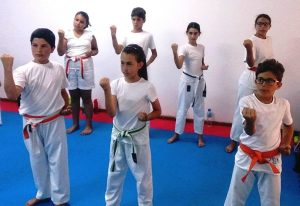
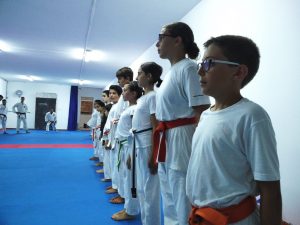
Having taught sports for quite a number of years I find that karate has no match as one of the best activities that children should participate in. The more reason is that, Karate provides the basis for a solid foundation for children to form their personality and attitudes.
However, one of the most important factors for this setup is providing the right instructor. Children are easily impressed and can be misled to confuse martial arts with aggression, especially if the training consists of dangerous applications intended to hurt others. Clubs that embrace such practice have a high rate of injuries which when sustained at a young age will be permanent throughout one’s lifetime.
On the other hand, a good teacher will provide excellent instruction to all the students without any preference to individuals. He or she would set the example in the dojo by constantly training and showing excellent technique. Hopefully their example will also consist of composed, relaxed and patient manners. An aggressive teacher would only promote aggression or other negative qualities that directly affect our internal health.
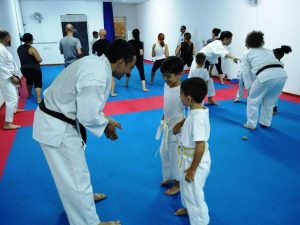
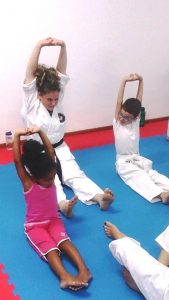
So why promote Karate for children. What are its benefits?
Karate provides three main benefits in the development of children. That is the mental, moral and physical development.
In terms of mental development, Karate builds concentration, focus, clear thinking and decisiveness.
Karate also has tremendous moral benefits as it helps to form distinguished characters. In fact true karate students are always noted as patient, disciplined and calm individuals. This is because karate builds confidence and self-control.
Physically karate is an excellent activity for the body. Not only for children but also for anyone with an open mind willing to train. Karate builds tremendous strength through stronger bones and muscles, and also stamina. It especially helps the body to become less susceptible to sickness and injury.
As a teacher, I would introduce karate in all the schools in Malta as I believe that the discipline would carry on in their everyday lives. Karate would help children learn how to deal with the many challenges facing them in today’s society. It would build the strong foundation needed on the principles of effort, self control, patience, honesty, courage, good manners and true friendships.
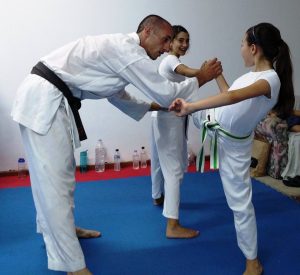
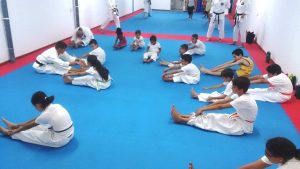
The aim of the Shotokan Karate-do Association is to teach the art of karate through technical skills and lifetime learning concepts. This is done in a safe and disciplined environment, where the children can develop their physical abilities, social skills and character through martial arts.
Frequently Asked Questions
Rightly so, one can question if training martial arts will make children aggressive. However studies have shown that people who train martial arts tend to handle aggressive encounters in a calm manner and are able to get out of the situation avoiding serious injuries. This is because apart from learning physical skills, karate teaches self-control, discipline, respect and perseverance.
We advise that at least children are 5 years old. At this age children start to grasp the concept of listening, paying attention to what is happening during class, able to perform what is being taught and interact with other students forming healthy relationships.
Children are grouped according to age and grade. However the instructor could make reasonable adaptations according to needs.
Although not compulsory, regular attendance is of high importance as this will instill the concepts of discipline and commitment in the child.
Yes. Every so often ‘gradings’ will take place whereby pupils are examined on their knowledge acquired so far and will be given the subsequent belt representing their level. This will provide a goal-oriented setting where the pupils can train with more determination to achieve and enhance their skills.
You have every right to do so. However, unless it is a very urgent situation, the instructor should not be interrupted during the session and be allowed to carry out the lesson prepared unobstructed.
A small group of dedicated black belts will be teaching your child and are guided by Sensei Edward Aquilina (5th Dan JKA Shotokan Karate, P.E teacher & Assistant Headmaster in Public Schools). More information about the instructors could be found in the instructors’ profiles.
Yes, this can be done either before or after the session. If you need to speak over a delicate matter, you could ask the instructor to meet you at a set time to be able to discuss things. However the instructor’s personal time should also be respected.
The instructors responsible for teaching children will build sessions based on the specific child development needs, always keeping a safety first attitude in whatever they do. This will reduce the risk for both acute and chronic injuries. Moreover, in the unlikely event that a child suffers an injury, a qualified first aider will always be present.
This is a very important question, as all club owners would recommend their training. However, what we suggest is that you do your personal research. At the end you want the best for your child, and this should always be the case. First of all one should look at the instructor’s attitude, etiquette and knowledge. This is done by speaking to the instructor before even considering the specific club. An ideal instructor should be smart, polite, knowledgeable about the subject, and love teaching. This would ensure that your child learns the good attitude, etiquette and discipline, along with the body movements. Moreover, one should look for instructor qualifications, other than Karate grade. Most instructors create their own grade, however, being a teacher, doctor, physiotherapist, rescuer, police officer, social worker, health & safety officer, lawyer etc…. will confirm further the knowledge and quality of the respective instructor and association. Price is always in question. Most people think that the larger the monthly fee, the better the level of instruction. This is not true at all. The best instructors are the ones who do not put income as the main aim for teaching. Last but not least, one should monitor the progress of the child after some time of practice. The most important thing is that the child is having fun, however, by time, good manners, obedience and improvement in physical ability should be clearly noticeable. If this is not the case one should consider furthering their research for other clubs.
This is understandable with our busy lifestyles. One should discuss with the instructors for other possibilities. Other training locations and training times are possible, however, this all depends on the demand.
Article was written by JKA Malta SKA Chief Instructor Sensei Edward Aquilina, 5th Dan, JKA, Assistant Head in a secondary school in Malta.